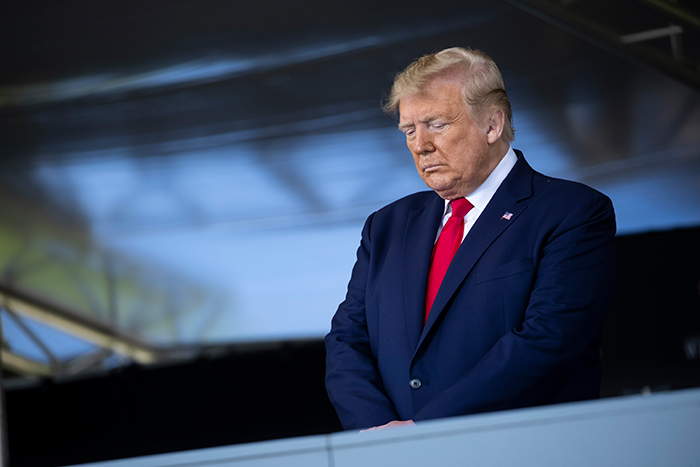
The images led to some elaborate online speculations and diagnoses, and for Trump, the attention clearly struck a nerve. Why else would the president take to Twitter to offer the excuse that the ramp was “very slippery” (a claim that a New York Times story labeled highly dubious)?
He might well be revealing his own insecurities. But he’s also right about one important thing: just how damaging such a picture of weakness can be. It may sound trivial, and it’s often unfair, but when a modern president, or even a candidate, exhibits physical weakness, it comes with a political cost.
It helped sink President Gerald Ford—perhaps the most athletic of our recent presidents; football star at the University of Michigan, skilled skier. But a couple of stumbles down the steps of Air Force One, a tumble on the ski slopes, and the relentless mockery of Chevy Chase on “Saturday Night Live” cemented a new image of Ford that stuck: A fumbling character barely able to put one foot in front of the other.
After him came President Jimmy Carter, who, in the midst of declining polls and a looming primary challenge from Ted Kennedy, sought to demonstrate his energy by entering a challenging six-mile race in the Catoctin Mountains in mid-September, 1979. Midway through the race, he all but collapsed into the arms of a Secret Service agent; pictures of the open-mouthed, utterly drained Carter became the symbol of an exhausted presidency.
Or think back to George H.W. Bush, whose appetite for recreation was on frequent display on golf courses, tennis courts and the water. But on January 8, 1992, in the middle of a state dinner in Japan, was struck by a flu bug and vomited. It became grist for the “SNL” mill, and helped underline the age difference between Bush and the much-younger Bill Clinton.
Without overstating the impact of these moments, it’s interesting to note that in each instance, the president lost his next election. And in 2016, so did challenger Hillary Clinton, whose coughing fits and use of back pillows became tropes in conservative media, fueling rumors circulated by the National Enquirer and others that she was virtually at death’s door.
We have, of course, had presidents hampered by genuine disability—none of whom suffered any kind of political damage for it. Franklin Roosevelt was struck by polio in August of 1921, leaving him unable to walk under his own power. His political career seemed doomed. But he was able to demonstrate enough mobility to maneuver himself to the rostrum of the Democratic convention in 1924 to put Al Smith’s name in nomination, and to demonstrate energy in other ways (he flew to Chicago in 1932 to accept the presidential nomination in person—a political first for a major party nominee). And while FDR’s condition was well known to the public, he was protected by a sympathetic press from any photographic evidence of his disability.
In the television age, John F. Kennedy provides a particularly illuminating case study. He was the living symbol of the “new generation” of leaders, the war hero who promised to “get America moving again,” the avatar of “vigor” who sponsored 50-mile hikes and whose family was associated with hardy outdoor pursuits like sailing, tennis and backyard football games. In reality JFK was afflicted by all manner of ills—Addison’s disease, colitis, ulcers, urinary tract infection and a back that kept him in chronic pain. But Kennedy and his enablers knew that any visible demonstration of physical weakness would undercut a major source of his appeal. (His doctors helped shield Kennedy’s condition from the press.)
Is this simply a demonstration of how the image has replaced reality in modern days? The preoccupation with physical vigor certainly isn’t new; in flogging his strength and stamina, Trump is drawing on a public fixation that has been part of our politics since, literally, the beginning. Of course George Washington would be our first president; he not only commanded the winning army, but was one of the tallest of public figures at the time. The U.S. has consistently turned to military heroes as presidential nominees, from Andrew Jackson to Zachary Taylor to Ulysses Grant to Benjamin Harrison to Theodore Roosevelt to Dwight Eisenhower to JFK. (It doesn’t always work, of course, or John Kerry, a tall military vet, pilot and impressive athlete, would have walked off with the 2004 election.)
The wish for vigor, surely, is in part a holdover from ancient times, when we wanted a leader who could fight off marauders from over the hill, but it still plays a role in the less rational part of our decision-making. Since 1900, two-thirds of presidential races have been won by the taller candidate; this may explain why, during the 2016 town hall debate, Donald Trump kept looming behind Clinton, as if to dramatize his stature.
Yes, it may seem absurd to argue that in a time of pandemic, economic catastrophe, demands for racial justice, and a president often at war with the norms of a Constitutional republic, that a couple of video images should really preoccupy either the president or his critics. But Donald Trump has a native instinct for knowing what matters—not what the pundits say, or what civics classes tell you, but what really sticks with people. And history says he’s right to be concerned about this one.
Source: politico.com
See more here: news365.stream






